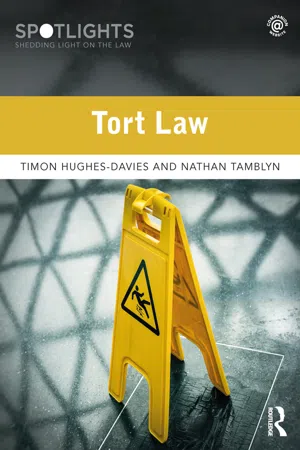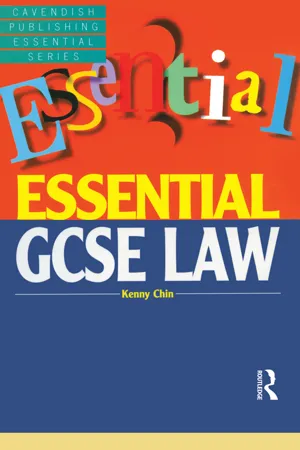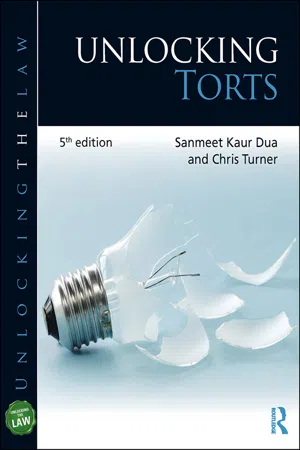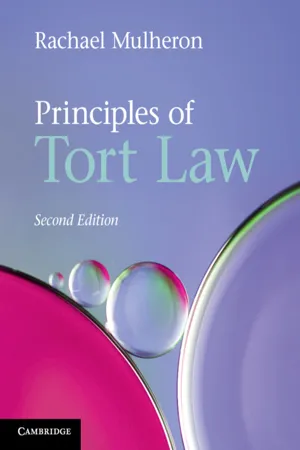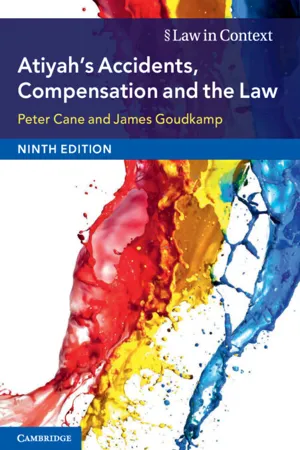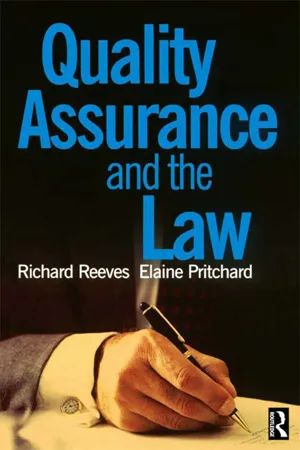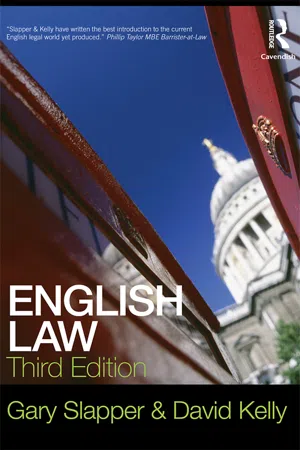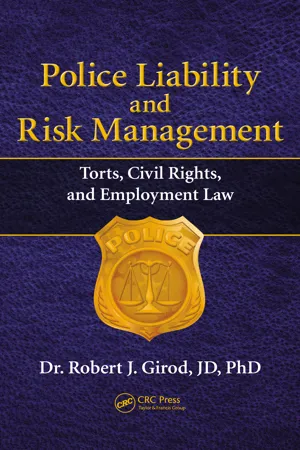Law
Breach of Duty
Breach of duty refers to the failure to meet the legal obligation or standard of care owed to another party. In legal terms, it involves a person or entity not fulfilling their duty to act reasonably or responsibly, resulting in harm or damage to another party. This concept is often central to negligence claims in legal proceedings.
Written by Perlego with AI-assistance
Related key terms
1 of 5
10 Key excerpts on "Breach of Duty"
- eBook - ePub
- Timon Hughes-Davies, Nathan Tamblyn(Authors)
- 2019(Publication Date)
- Routledge(Publisher)
Chapter 3Negligence: Breach
3.1 Introduction
Breach is the second element of the tort of negligence. The claimant has to show that the defendant not only owed him or her a duty of care, but also that the defendant breached the duty.Figure 3.1 The elements of negligence: breachThe law adopts an objective standard: if the defendant did something that a reasonable person would not have done, or did not do something which a reasonable person would have done in the circumstances, then there will usually be a breach of the duty. Why the defendant breached the duty is less important. It does not matter that the defendant was tired, or distracted, or inexperienced.1 The well-meaning, but incompetent, defendant is just as liable as the lazy or reckless defendant.1 Nettleship v Weston [1971] 2 QB 691.The law does, however, take the circumstances into account. Obviously, it would be unreasonable for a driver to go through a red light in ordinary circumstances. But if the person is driving an ambulance, then the same act may be reasonable.____________As you read
- Understand the standard of care and what is meant by breach.
- Identify the duty of care as applied to children.
- Understand the care to be taken when vulnerable people and children may be involved.
- Understand the test applied in professional negligence.
3.2 Reasonable care
The duty of care is a duty to take reasonable care not to cause damage to the claimant. As a nineteenth-century judge put it, ‘negligence is the omission to do something which a reasonable man, guided upon those considerations which ordinarily regulate the conduct of human affairs, would do, or doing something which a prudent and reasonable man would not do’.2 - eBook - ePub
- Kenny Chin(Author)
- 2014(Publication Date)
- Routledge-Cavendish(Publisher)
Injunction is an equitable remedy which will be appropriate when damages are not adequate in matters such as threatened or repeated trespass and nuisance. There are other remedies including abatement and forcible ejection. The former is available in nuisance and the latter for trespass to land. Such defences will be discussed in the sections regarding the relevant torts.NegligenceNegligence in a general sense could mean carelessness causing personal injury, damage to property or financial losses. Contractual obligations have been well established. Students will note that most contract law cases date back to the 19th century. The duty of care in negligence is a relatively new concept. Since the classic case of Donoghue v Stevenson (1932), the courts recognise that citizens living amongst each other have a legal duty to take care when they go about their business and to avoid causing harm to others. There is a standard of care we should take and if we fall foul of this generally accepted standard (that is, breach of the duty) and cause damage to another then we are liable to pay compensation. This concept of duty of care is not very different from that of obligation arising from an agreement. Maybe we can say that the courts have ‘stolen’ the idea in contract to be used in tort.As mentioned in earlier sections, tort requires fault and harm. The fault elements in negligence are the duty of care and a breach of that duty. A successful claimant in negligence must therefore prove three things:(a) that the defendant owes him a duty of care; (b) that the defendant has breached that duty (that is, fallen foul of the standard of care); (c) that he has suffered damage caused by the breach and are not too remote. Duty of careBefore the case of Donoghue v Stevenson (1932), it was difficult to claim compensation in a civil court without relying on a contract or on other established tort like nuisance and trespass. Mrs Donoghue’s friend bought her a bottle of ginger beer and after she drank it she discovered the remnants of a decomposing snail in the bottle. She was ill afterwards. Mrs Donoghue had not bought the beer, so she was not a party to the contract and, therefore, could not sue the manufacturer under contract. She sued for negligence. Lord Atkins in the House of Lords delivered his ratio - eBook - PDF
- Kim Atkins, Sheryl de Lacey, Bernhard Ripperger, Rebecca Ripperger(Authors)
- 2020(Publication Date)
- Cambridge University Press(Publisher)
Accordingly, most cases of professional negligence relating to health-care profes- sionals involve arguments about Breach of Duty, causation and damage. Breach of Duty As noted above, a Breach of Duty will be found where a person fails to take rea- sonable steps to prevent a foreseeable injury. This is sometimes referred to as the ‘reasonable standard of care’, which exists because of the duty of care owed by the defendant to the plaintiff. This is the standard that applies in most ordinary cases of negligence – for example, a person driving a car must drive in a way to avoid injury to other road users. However, the law has developed a different approach to determining the standard of care owed by a professional, including a health- care professional, when they are providing a professional service. The nature of CHAPTER 5: DUTY OF CARE AND PROFESSIONAL NEGLIGENCE 121 this duty of care was examined by the High Court of Australia in the landmark case of Rogers v Whitaker (1992). In that case, the High Court confirmed that the duty of care owed by a health-care professional to a patient was a ‘single compre- hensive duty’. However, because of the nature of this relationship, different fac- tors are to be considered by the court when determining whether there has been a breach of that duty. In particular, the approach taken by the court in determin- ing the reasonable standard of care to be provided in cases involving diagnosis or treatment of a patient will be different to the approach taken in cases involving the provision of advice. The facts of Rogers v Whitaker were that the patient had injured her right eye in a childhood accident and was almost totally blind in that eye. An ophthalmic surgeon advised her that an operation on her right eye would not only improve its appearance but would probably also restore sight. - eBook - ePub
- Sanmeet Kaur Dua, Chris Turner(Authors)
- 2019(Publication Date)
- Routledge(Publisher)
3Negligence: Breach of Duty
AIMS AND OBJECTIVES
After reading this chapter you should be able to:■ Identify the relevant measure of care applicable to non-professionals and professionals■ Explain and apply the general standard of care■ Explain and apply the standard of care applicable to professionals, particularly doctors■ Identify the factors used in determining whether a defendant has fallen below the standard of care appropriate to the duty owed■ Critically analyse the concepts of standard of care and Breach of Duty of care■ Identify the appropriate standard of care in factual situations■ Apply the factors for determining breach to factual situations in order to establish if a breach has occurred3.1 The standard of care and the ‘reasonable man’ test
3.1.1 The standard of care
We have already seen how negligence occurs where a person owing a duty of care to another person breaches that duty and causes damage which is not too remote a consequence of the Breach of Duty.Breach of Duty, the second element of negligence, actually refers to the standard of care that is appropriate to the duty owed. A Breach of Duty simply occurs when the party owing the particular duty falls below the standard of behaviour that is required by the particular duty in question.The judge in the case will determine the standard of care and whether or not the defendant’s behaviour has fallen below that standard according to established tests. While the standard of care in any situation is a question of law, whether or not the defendant has fallen below the standard is a question of fact that will be determined by reference to all of the circumstances of the case.The standard of care required is generally measured according to an objective method of testing. In this way, while what is the appropriate standard is obviously determined factually according to the circumstances of the case, it is nevertheless the standard that would have been adopted by a ‘reasonable man’ confronted by the same circumstances that will be taken as the measure by which the defendant’s actions will be judged. - eBook - PDF
- Rachael Mulheron(Author)
- 2020(Publication Date)
- Cambridge University Press(Publisher)
Hence, this ele-ment has not attracted much discussion in the context of ‘stress-at-work’ claims. The Rest of the Cause of Action Breach of Duty must be proven in the usual way, as noted in Hatton . Hence, the principles in Chapter 7 are pertinent. For example, in Daw v Intel Corp , 355 Pill LJ remarked that the provision of counselling services would not automatically preclude a finding of breach (although such a step will always be relevant, per Hartmann v South Essex Mental Health NHS Trust 356 ). The usual principles of causation (per Chapter 8 ) and remoteness (per Chapter 9 ) will also apply. 288 6 Breach I – The Standard of Care Under the second element of the tort of negligence, the relevant question is whether the conduct of D fell below the standard of care which the law expects of D and so constitutes negligent behaviour. This enquiry necessarily involves a two-stage analysis: (1) setting the standard of care against which D’s behaviour should be judged (a question of law); and (2) deciding whether D’s conduct met, or fell below, that standard (a question of fact). This chapter considers the first enquiry, while Chapter 7 considers the second. INTRODUCTION Reasonableness, not Perfection The Requisite Legal Standard §6.1 The law of negligence imposes a reasonable standard of care on D, and not a standard of per-fection (the latter would, if permitted, impose a form of strict liability). Fixing the requisite reasonable standard of care in any given case is a question of law. That proposition was espoused in the seminal judgment of Lord Atkin in Donoghue v Stevenson 1 : ‘You must take reasonable care to avoid acts or omissions which you can reasonably foresee would be likely to injure your neighbour.’ In Bolton v Stone too, 2 the House of Lords remarked that ‘[t]he standard of care in the law of negligence is the standard of an ordinarily careful man’ – or an ordinarily careful cricket club, in that case. - eBook - PDF
- Peter Cane, James Goudkamp(Authors)
- 2018(Publication Date)
- Cambridge University Press(Publisher)
These developments in the law relating to duty of care have mainly affected liability in the tort of negligence for purely economic loss, that is, loss other than injury to person or damage to tangible property, and economic loss conse- quential on such injury or damage. In the typical case of personal injury (except ‘nervous shock’) or damage to tangible property, foreseeability is, in practice if not in theory, the sole criterion of the existence of a duty of care. Therefore, none of the threefold test, the assumption of responsibility test, or the incre- mental approach, is of much importance to the subject-matter of this book. It should also be noted that, whereas Lord Atkin seems to have put forward the neighbour principle as a way of expanding the scope of liability for negligence, the duty of care concept is most commonly used in modern cases as a means of justifying a refusal to impose liability for negligence. This brief account of the law indicates that the main function of the concept of duty of care is to define the boundaries of liability for damage caused by negligent conduct by reference to what are commonly called ‘policy considerations’. 6 So, for example, for fairly obvious reasons, soldiers owe no duty of care to fellow soldiers when engaging the enemy in battle; neither is the army under a duty to provide a ‘safe system of work’ on the battlefield. 7 Until relatively recently, barristers owed no duty of care to their lay clients in the conduct of litigation 4 The test originated in Hedley Byrne & Co. Ltd v. Heller [1964] AC 465. 5 Robinson v. Chief Constable of West Yorkshire Police [2018] UKSC 4. 6 The leading analysis of the (staggeringly wide) range of policy factors to which the courts have regard is J. Stapleton, ‘Duty of Care Factors: A Selection from Judicial Menus’ in P. Cane and J. Stapleton (eds), The Law of Obligations: Essays in Celebration of John Fleming (Oxford, 1998). - eBook - PDF
- Mark Butlin, Noeleen McNamara, Kerrie Anglin(Authors)
- 2021(Publication Date)
- Cambridge University Press(Publisher)
NEGLIGENCE To be successful in a claim of negligence and obtain redress for the loss suffered at the hands of the school or school authority, the plaintiff (usually the student and/or his/her family) has to prove three things. First, the plaintiff has to demonstrate that a duty of care is owed by the school to the student. This is the easiest element to prove as it is clearly articulated in statute law across the various jurisdictions in Australia – for example, Education (General Provisions) Act 2006 (Qld). Second, the plaintiff has to show that the school or one of its staff members (e.g. a teacher) has breached that duty of care owed or failed to exercise the level of care that it should have. This breach can be either what the staff member has done or what they failed to do, commonly known as an omission. There are a number of determining factors that the court considers when determining whether or not there has been a breach. Third, the student must establish that he or she has suffered some degree of injury or loss directly resulting from the breach of the duty of care. There has to be some clear or causal link between the suffering and the breach of the duty of care. These three elements will be explored further below, with reference to relevant court cases to help explain how each work in a more practical sense in the school environment. Duty of care: a legal obligation to ensure the wellbeing and safety of others. For example, schools and teachers owe a duty of care to their students Law: an external set of rules and regulations that apply to all people with particular ramifications if breached Negligence: when there was a duty of care owed (e.g. by a teacher to a student), that duty of care was breached, and damage resulted from that breach Breach: when someone has not prevented a risk of harm to a person they owe a duty of care to 10 Law and Ethics for Australian Teachers - eBook - ePub
- Elaine Pritchard, Richard Reeves(Authors)
- 2013(Publication Date)
- Routledge(Publisher)
However, it should be noted that claims of negligence are the most commonly arising of all the torts for it covers a host of illnesses which may arise through working conditions, accidental injury situations or harm which may arise as a result of medical treatment. All of these areas could well be encompassed within a company’s quality or combined quality/safety procedures. In addition to which, negligence also affords a degree of consumer protection, which is an area with which all quality assurance management systems should be concerned. An additional point to be borne in mind is that, it is not only negligent acts which need to be avoided. People involved with giving professional advice, such as lawyers, accountants and surveyors, need also to be aware of the potential liability they face for any negligent statements that they may make, or advice they may give. As with all civil law, the burden of proof is on the plaintiff. The plaintiff must prove his case on the balance of probabilities. In cases of negligence the plaintiff has to be able to prove the other party was negligent. This is known as fault liability. To be successful in a negligence action, the plaintiff must show the following. 1 that the defendant owed the plaintiff a duty of care; 2 there was a breach of that duty of care; and 3 loss or injury arose directly as a result of that Breach of Duty of care. The concept of a duty of care, was derived from case law rather, than from an Act of Parliament. Similarly exactly what constitutes a breach of that duty and whether or not injury arose directly because of the breach is also governed by case law. As a result the following pages contain an explanation of these terms together with the relevant cases from which they were derived, refined or put to the test. Duty of Care Since the case of Donoghue v. Stevenson (1932) a manufacturer can be sued in the tort of negligence for harm caused by a defect in their product - eBook - ePub
- Gary Slapper, David Kelly(Authors)
- 2009(Publication Date)
- Taylor & Francis(Publisher)
The tort of negligence7.1 Introduction
Negligence is a tort. It is, however, necessary to define what is meant by ‘a tort’ before considering the essentials of negligence. A tort is a wrongful act against an individual or body corporate or his, her or its property, which gives rise to a civil claim (usually for damages, although other remedies are available). Principally, liability is based on fault, although there are exceptions to this such as breach of statutory duty, vicarious liability and the tort established in Rylands v Fletcher (1865). The motive of the defendant in committing the tort is generally irrelevant.Negligence is the most important of all the torts, not only because an understanding of it is vital to the comprehension of other torts, such as employers’ and occupiers’ liability, but also because it is the one tort which is constantly developing in the light of social and economic change. This can be seen by reference to product liability, professional negligence and economic loss, all of which were originally only compensated if there was in existence a valid contract; in other words, ‘no contract, no claim’. After a period of continual development in the scope and application of this tort, there are signs that the courts are beginning to be more cautious. They are aware of the economic implications for the public and private sectors if they continue to extend the scope of actions in negligence. Whether this should be an issue for the courts is always open to debate, but if the courts are to be pragmatic, then they may have no choice but to be restrained in the current economic climate.A professional person, such as an auditor, accountant, lawyer or doctor, may find themself in a non-contractual relationship with another who will have little choice but to pursue a claim in negligence if they are injured as a result of professional malpractice. Indeed, in order to cover potential claims in negligence and contract, many professional bodies require, as part of membership approval and the issue of practising certificates, that their members take out insurance cover to meet the cost of potential claims (usually, a minimum amount of cover is stipulated for an individual claim). This is known as professional indemnity insurance. - No longer available |Learn more
Police Liability and Risk Management
Torts, Civil Rights, and Employment Law
- Robert J Girod(Author)
- 2013(Publication Date)
- Routledge(Publisher)
(Fielder v. Jenkins, 633 A.2d 906 (N.J. Super. A.D. 1993)). The accident may have occurred regardless of the officer’s behavior (be aware of possible exceptions to this rule) (p. 27).Damage or Injury
Once a plaintiff has shown a duty, breach of that duty, and the proximate cause of injury, the plaintiff must show actual damage or harm, which substantially interfered with an interest of the individual or his/her property. Kappeler (2006) says that general or technical violations of a duty “that do not significantly interfere with the interests of a specific individual do not satisfy the damage element under negligence tort.” The plaintiff must prove some actual damage or injury. The potential for future damage alone is not sufficient to satisfy the damage element of negligence. There must be actual damage or injury (p. 28).Negligence Formula
A person is not negligent if there is small possibility that his conduct will injure another. Conduct that is reasonable and has low probability of resulting in harm to others is not negligence (Lubitz v. Wells, Conn. Sup. Ct., 19 Conn. Supp. 322,113 A.2d 147 (1955)). Negligence involves the creation of an “unreasonable risk,” by act or omission that a reasonable and prudent man would not create (Blyth v. Birmingham Waterworks Co., Exchequer, 11 Exch. 781 (1856)). The reasonable person standard is the standard of care exercised by a hypothetical person who possesses the intelligence, education, knowledge, attention, and judgment of an average (reasonable) person. This standard applies to a person’s judgment when determining breach of a duty under the theory of negligence.An action for negligence exists when the defendant incurs a risk that makes the possibility of harm real enough so that a person of “ordinary prudence” would take some action to avert the threatened danger. In Gulf Refining Co. v. Williams, Miss. Sup. Ct., 183 Miss. 723, 185 So. 234 (1938), the court held that the test of foreseeability is not
Index pages curate the most relevant extracts from our library of academic textbooks. They’ve been created using an in-house natural language model (NLM), each adding context and meaning to key research topics.
